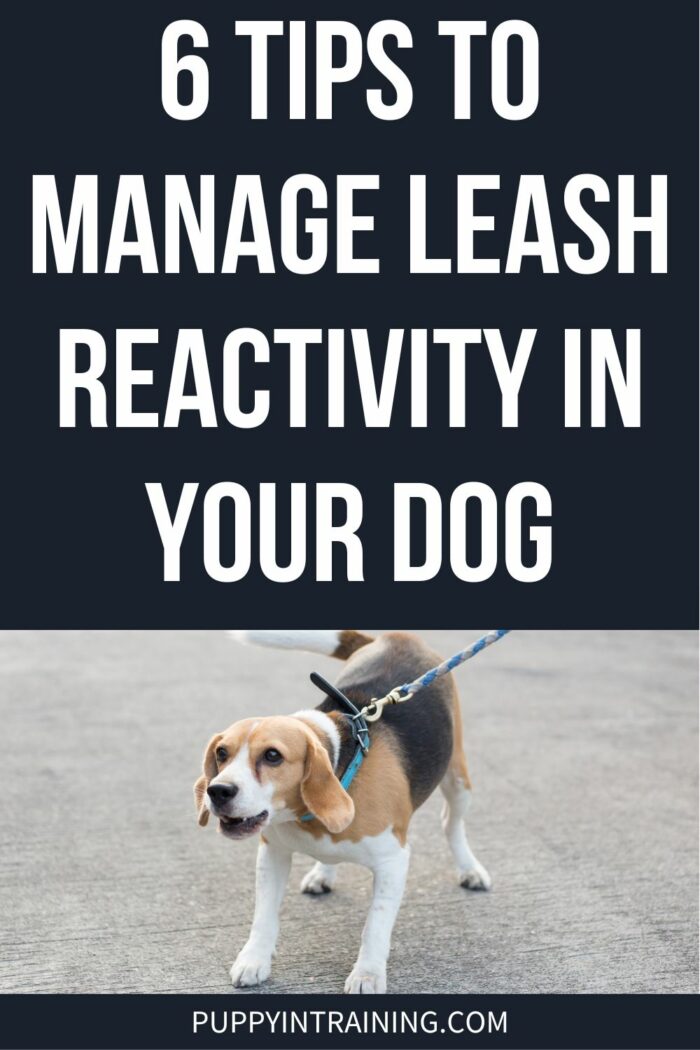This post may contain affiliate links. We may earn money or products from the companies mentioned in this post.
As a dog parent, it can be frustrating and embarrassing to have your dog act out in public each time another dog or a person is near.
But for your dog, leash reactivity is often more than an annoyance.
In these moments of reactivity, your dog may be battling with overwhelming feelings of fear, anxiety, or stress.
By understanding your dog’s reactivity and the triggers that cause it, you can start to address the problem.
Managing leash reactivity isn’t easy, but it will allow you to prevent a potentially dangerous situation and give your dog the best possible life.

What is Leash Reactivity?
The term “leash reactivity” refers to any situation in which a dog becomes overexcited or overstimulated in response to a trigger while on leash.
This trigger could include a variety of different things, including (but not limited to):
- People or children
- Other dogs
- Farm animals
- Wildlife (squirrels, rabbits, birds)
- Cars
- Bicycles
- Strollers or wagons
- Specific clothing items (hats, bulky winter clothing, etc.)
If your dog is reactive on leash, it could present as being overly excited, freezing up or shutting down, or with behaviors that may be mistaken as aggression, such as growling and lunging.
Other examples of leash reactivity include biting at the leash, attempting to run away from the trigger, or barking.
Is Leash Reactivity Aggression?
The terms “reactivity” and “aggression” are often used interchangeably. Both behaviors refer to a dog overreacting to a trigger but represent different response levels.
A reactive dog hasn’t yet reached the level of aggression, but this doesn’t mean it won’t get to that state.
If your dog shows signs of leash reactivity, it must be addressed promptly. Left unmanaged, reactivity can escalate to aggression.
What Causes a Dog to be Leash Reactive?
The biggest misconception regarding leash reactivity is that every reactive dog is responding to an abusive past.
While this is true for some, there are many other possible causes.
Not all dogs that are reactive respond in that way due to fear or anxiety.
In some cases, the reactivity that you see results from your dog being overly excited by the presence of their trigger.
When I first adopted our oldest dog Daviana, that was the exact situation we were dealing with.
Daviana was showing a lot of leash reactivity toward other dogs. She would bark, pull at the leash, and even grab it to try to pull free.
This wasn’t aggression. It was excitement to play. When off-leash, she played with other dogs incredibly well.
The leash restrained her and prevented her from reaching the dogs she wanted to play with. This caused her to feel overexcited and frustrated.
Some of the most common causes of leash reactivity in dogs include the following:
- Lack of socialization/uncertainty in new situations
- Fear of the unknown
- A previous traumatic experience (like a negative experience with another dog)
- Barrier frustration
In some dogs, reactivity is a response to having been previously corrected for responding to a trigger.
Picture a young dog that jumps at the end of the leash or barks in excitement each time they see another dog.
If the owner uses aversive training approaches to try to stop the jumping (punishing the behavior), the dog may make a connection between the punishment and the trigger.
Do Reactive Dogs Calm Down with Age?
No, unlike some behaviors associated with the puppy stages of maturity, leash reactivity isn’t a behavior they will grow out of.
Ignoring the behavior in the hope that it will go away with time will likely only worsen your dog’s reactivity.
You should consider consulting a professional for dog reactivity training to address the problem.
This includes training commands that can help prevent a situation from developing and counterconditioning to change how your dog reacts to their trigger(s).
6 Tips to Manage Leash Reactivity
1. Identify Your Dog’s Triggers
Pay careful attention to what sets your dog off. They could get over-excited seeing other dogs like Daviana or are afraid of men with beards.
By identifying and understanding your dog’s triggers, you have the information necessary to avoid putting your dog into a problematic situation.
2. Advocate for Your Dog in Public
If you find yourself in a situation where someone is testing or ignoring your dog’s boundaries, don’t wait until it escalates into a reactive situation.
Instead, be prepared to advocate for your dog to prevent it from happening.
Our youngest dog Lucifer is still working on overcoming fear-based reactivity toward strangers.
To ensure that people respect his boundaries, we have a leash sleeve that states “Do Not Approach.”
I am also prepared to stand up for my dog if needed.
When someone approaches us and ignores the leash sleeve, I will place myself between Lucifer and the individual and make it clear that they are not to come any closer.
Many years ago when Colby attended America’s Family Pet Expo there was a company that created special leashes, collars, ribbons, and vests to help signify that your dog is reactive, in training, etc.
Colby thinks this is a great idea, however, average dog owners will probably not understand the significance of the different colors and therefore reduce the effectiveness of colored leashes, ribbons, and collars.
3. Recognize the Signs of Discomfort
Before reacting, your dog will try to communicate that they are uncomfortable.
By recognizing these signs, you can take steps to get your dog out of the situation before it escalates to a reactive response.
Common signs of discomfort, anxiety or heightened arousal in dogs include:
Don’t wait for your dog to react. A proactive response will be more comfortable for both of you.
4. Learn How to Navigate Challenging Situations
There will come a time that you are forced to get closer to your dog’s triggers than you would like.
You may be passing a dog on the street or approaching another hiker on a narrow trail.
Find ways to make your dog more comfortable.
This could be leading them off the trail to sit and wait until the trigger has passed or moving in an arc around the trigger to avoid getting any closer than necessary.
Reward your dog as the trigger passes and the situation is resolved. This will help create a positive association with seeing their trigger.
5. Consider Muzzle Training
If your dog’s reactivity includes a tendency to bite or snap, you may consider using a basket muzzle when you are out in public.
This not only protects others, but it will also help to keep your dog safe from their own reactions.
Basket muzzles offer enough space for your dog to pant comfortably without any restrictions. Dogs can also eat or drink while wearing one.
6. Consult a Professional
While many dog parents will feel comfortable taking on basic obedience training, working with a reactive dog introduces new challenges and potential consequences, especially if they are lashing out in response to their fear and anxiety.
The best way to address leash-reactive dog training is to do so with the guidance of a knowledgeable professional.
Contact a canine behaviorist or a trainer with previous experience working with reactive dogs.
If you’re unsure where to start, try searching the directory on the American College of Veterinary Behaviorists website.
Final Thoughts
If your dog is showing signs of leash reactivity, don’t be discouraged.
The sooner your start working on counterconditioning or desensitizing your dog, the better your chances of success.
Some dogs will learn to exist in close proximity to their trigger without responding. But not every dog will make a complete recovery.
Be prepared to manage your dog’s environment and advocate for your dog moving forward.
Do you have any experience with a leash-reactive dog?
If so, we’d love to hear about your experiences and how you managed their reactivity in the comment section below.
Save To Pinterest

Top Picks For Our Puppies
- BEST PUPPY TOY
We Like: Calmeroos Puppy Toy w/ Heartbeat and Heat Packs – Perfect for new puppies. Helps ease anxiety in their new home. - BEST DOG CHEW
We Like: Mighty Paw Naturals Bully Sticks – All of our puppies love to bite, nip, and chew. We love using Bully Sticks to help divert these unwanted behaviors. - BEST DOG TREATS
We Like: Crazy Dog Train-Me Treats – We use these as our high-value treats for our guide dog puppies. - BEST FRESH DOG FOOD
We Like: The Farmer’s Dog – A couple months ago we started feeding Raven fresh dog food and she loves it! Get 50% off your first order of The Farmer’s Dog.
Check out more of our favorites on our New Puppy Checklist.



